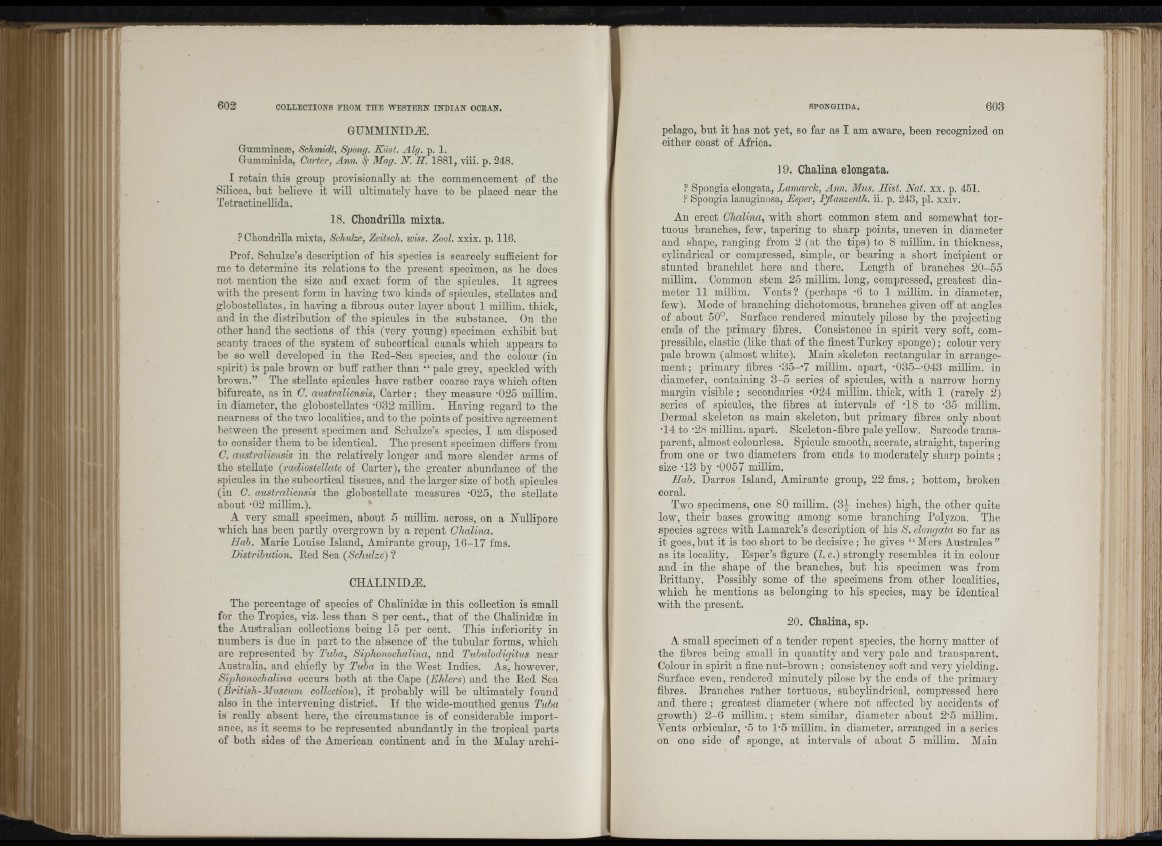
11
ÏÜH
i i :
r,
!i U : |
i i i f ; i !
H i :
tt
GUMMINIDÆ.
Gummineæ, Schmidt, Spong. Kiist. Alg. p. 1.
Gumminida, Carter, Ann. Mag. N. H. 1881, viii. p. 248.
I retain this group provisionally a t the commencement of tho
Silicea, but believe it wiU ultimately have to be placed near tbe
Tetractinellida.
18. Chondrilla mixta.
? Obondrilla mixta, Schidze, Zeitsch. wiss. Zool. xxix. p. 116.
Prof. Schulze’s description of his species is scarcely sufficient for
me to determine its relations to tbe present specimen, as be does
not mention the size aud exact form of tbe spicules. I t agrees
with tbe present form in having two kinds of spicules, stellates and
globostellates, in having a fibrous outer layer about 1 millim. thick,
and in tbe distribution of the spicules in tbe substance. On the
otber hand the sections of this (very young) specimen exhibit but
scanty traces of the system of subcortical canals which appears to
be so well developed in tbe Red-Sea species, and tbe colour (in
spirit) is pale brown or buff ratber than “ pale grey, speckled witb
brown.” Tbe stellate spicules have rather coarse rays wbicb often
bifurcate, as in C. australiensis. Carter; they measure -025 miUim.
in diameter, tbe globostellates "032 millim. Having regard to tbe
nearness of tbe two localities, and to tbe points of positive agreement
between the present specimen and Schulze’s species, I am disposed
to consider them to be identical. The present specimen differs from
C. australiensis in the relatively longer and more slender arms of
the stellate {radiostellate of Carter), tbe greater abundance of tbe
spicules in the subcortical tissues, and tbe larger size of both spicules
(in C. australiensis the globostellate measures -025, the stellate
about -02 millim.).
A very small specimen, about 5 millim. across, on a Nullipore
wbicb bas been partly overgrown by a repent Chcdina.
Hah. Marie Louise Island, Amirante group, 16-17 fms.
Distrihution. Ped Sea (Schulze) ?
CHALINIDÆ.
The percentage of species of Chalinidæ in this collection is small
for tbe Tropics, viz. less than 8 per cent., th at of tbe Cbabnidæ in
tbe xiustralian collections being 15 per cent. This inferiority in
numbers is due in part to the absence of the tubular forms, which
are represented by Tuha, Siphonochalina, and Tubulodigitus near
Australia, and chiefly by Tuba in the AYest Indies. As, however,
Siphonochalina occurs botb at tbe Cape (Ehlers) and tbe Red Sea
(British-Aluseum collection), it probably will be ultimately found
also in tbe intervening district. If the wide-moutbed genus Tuba
is really absent here, tbe circumstance is of considerable importance,
as it seems to be represented abundantly in tbe tropical parts
of botb sides of tbe American continent and in tbe Malay arcbipelago,
but it has not yet, so far as I am aware, been recognized on
either coast of Africa.
19. Chalina elongata.
? Spongia elongata, Lamarck, Ann. Mus. Hist. Nat. xx. p. 451.
? Spongia lanuginosa, Esper, Pflanzenth. ii. p. 243, pi. xxiv.
An erect Chalina, with short common stem and somewhat to rtuous
branches, few, tapering to sbarp points, uneven in diameter
and shape, ranging from 2 (at tho tips) t-o 8 millim. in thickness,
cylindrical or compressed, simple, or bearing a short incipient or
stunted brancblet here and there. Length of branches 20-55
millim. Common stem 25 millim. long, compressed, greatest diameter
11 millim. Vents? (perhaps -6 to 1 millim. in diameter,
few). Alode of branching dichotomous, branches given off at angles
of about 50°. Surface rendered minutely pilose by the projecting
ends of tbe primary fibres. Consistence in spirit very soft, compressible,
elastic (like th a t of tbe finest Turkey sponge); colour very
pale brown (almost white). Main skeleton rectangular in arrangement;
primary fibres •35-'7 millim. apart, •035-D43 millim. in
diameter, containing 3 -5 series of spicules, witb a narrow horny
margin visible; secondaries -024 millim. thick, with 1 (rarely 2)
series of spicules, tbe fibres at intervals of -18 to -35 millim.
Dermal skeleton as main skeleton, but primary fibres only about
•14 to ‘28 millim. apart. Skeleton-fibre pale yellow. Sarcode transparent,
almost colourless. Spicule smooth, acerate, straight, tapering
from one or two diameters from ends to moderately sharp points ;
size -13 by -0057 millim.
Hab. Darros Island, Amirante group, 22 fms.; bottom, broken
coral.
Two specimens, one 80 millim. (34 inches) high, the other quite
low, tbeir bases growing among some branching Polyzoa. The
species agrees witb Lamarck’s description of bis S . elongata so far as
it goes, but it is too short to be decisive ; he gives “ Alers Australes ”
as its locality. Esper’s figure (I. c.) strongly resembles it in colour
and in tbe shape of tbe branches, but bis specimen was from
Brittany. Possibly some of tbe specimens from other localities,
wbicb be mentions as belonging to bis species, may be identical
witb tbe present.
20. Chalina, sp.
A small specimen of a tender repent species, the horny matter of
tbe fibres being small in quantity and very pale and transparent.
Colour in spirit a fine nut-brown ; consistency soft and very yielding.
Surface even, rendered minutely pilose by tbe ends of tbe primary
fibres. Branches rather tortuous, subcylindrical, compressed here
and there ; greatest diameter (where not affected by accidents of
growth) 2 -6 millim.; stem similar, diameter about 2-5 millim.
Vents orbicular, -5 to 1-5 millim. in diameter, arranged in a series
on one side of sponge, at intervals of about 5 millim. Main
1 'i'
* IÎ; ! ii
'!
l i e